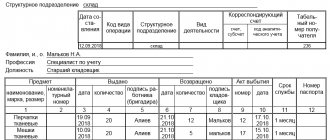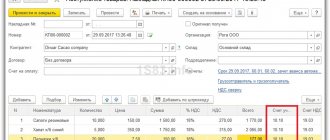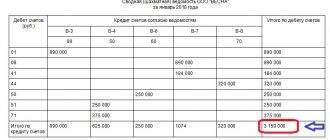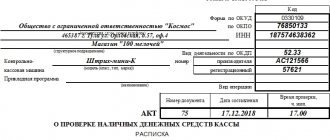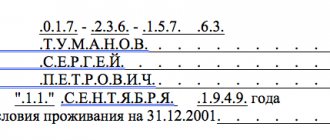In this material we will look at why you need and how to fill out the MB-4 form (Act of disposal of low-value and wear-and-tear items). Let's talk about where to submit it and what details are needed to fill it out correctly. We will discuss common mistakes and answer the most common questions. We will also give recommendations on how to fill out the form.
Many organizations, especially those engaged in production activities, acquire ownership of property that does not have a high cost and a long service life. This category of valuables is included in the group of low-value and wearable objects. Despite the small costs associated with the acquisition, enterprises need to organize warehouse accounting and ensure control over the issuance of low-value property to employees.
The document flow system for objects that do not have a high value involves accounting forms developed at the legislative level and used in Russia.
Important! Companies have the opportunity to use documents approved independently if they contain all the required details.
One of the documents used to reflect transactions with low-value property is the disposal act in the MB-4 form.
Form MB-4 (Act of disposal of low-value and wear-and-tear items): what is it?
The act of disposal of IBP is a sample document approved by Decree of the State Statistics Committee No. 71a of October 30, 1997. The form of the form is unified and has a code in accordance with the OKUD classifier 0320002. This document is successfully used by Russian organizations to record the movement of low-value items in accounting.
This document is drawn up in cases where low-value property transferred for use to an employee of the organization is lost, worn out or damaged.
We recommend that you familiarize yourself with a sample form of the MB-4 form.
In the event that the MBP (of any type) is worn out, obsolete or completely unusable for other objective reasons, they are written off; the basis for their write-off is the drawn up Act for the write-off of low-value and wear-out items (form No. MB-8).
The act is drawn up in one copy according to the data of one-time acts (form No. MB-4) and serves as the basis for writing off the IBP and as a document for the receipt of scrap. The act signed by the storekeeper is transferred to the accounting department. [p.168] Documents for accounting for the consumption of seeds, planting materials, mineral fertilizers, materials for routine repairs of fixed assets are requirements-invoices, limit-fence cards, acts on the use of fertilizers and pesticides, acts on the write-off of seeds. For worn-out or low-value and wear-out items released into production, a write-off act for low-value and wear-out items is drawn up. The removal of manure from livestock farms to fields or vegetable gardens is documented. Auxiliary production services provided to the crop growing industry are reflected in the production reports of vehicles, repair shops, power plants, etc. [p.307] Accrual of depreciation of low-value equipment (cans, tubs, feeders, etc.) is carried out when it is released into operation on the basis of invoice requirements for the release of equipment from the storeroom into operation, and its write-off is carried out according to acts for the write-off of low-value and wear-out items . [p.311]
An act for writing off low-value and wear-out items (form No. MB-8) is used to register worn-out and unsuitable for further use MBP. [p.492]
MB-8 Act on write-off of low-value and wearable items [p.276]
The accounting department of a construction organization, on the basis of an approved act for the write-off of low-value and wear-out items that have fallen into disrepair, credits account No. 12 Low-value and wear-out items under subaccount JVb 2 In operation and debits account No. 13 Wear of low-value and wear-out items for the full cost of the items being written off, with the exception the cost of scrap at the price of its possible use. For the cost of materials subject to capitalization, at the price of possible use, account No. 07 Construction materials and equipment for installation is debited under subaccount No. 3 Other materials and account No. 12-2 Low-value and wear-and-tear items is credited. Since the depreciation of low-value and high-wear items is not fully accrued, additional depreciation is accrued for the difference between the initial cost of low-value and high-wear items, the amount of accrued depreciation and the cost of materials capitalized from write-off. For the amount of additional accrued depreciation, account No. 27 Overhead expenses or other accounts are debited depending on the purpose of the items and account No. 13 Wear of low-value and wear-out items is credited. For example, the initial cost of low-value and rapidly wearing items subject to write-off due to wear and tear, according to the approved act, is 1843 rubles. the amount of accrued depreciation for these items is 922 rubles. the cost of materials subject to capitalization (scrap metal and others) is 57 rubles. [p.119]
To reflect the operations of the movement of small and medium-sized items (receipt, internal movement, transfer to operation, write-off), unified forms of primary accounting documentation are intended: cards for recording low-value and wear-out items (form MB-2) (see below) act of disposal of low-value and wear-out items (form MB- 4) a record sheet for the issuance of work clothes, safety shoes and safety devices (form MB-7); an act for writing off low-value and wear-out items (form MB-8). [p.17]
The act of writing off low-value and wear-out items (form No. MB-8) is used to formalize the write-off of worn-out and unsuitable for further use low-value and wear-out items. This act is drawn up in one copy by the commission. After handing over the written-off items to the scrap storage room, form No. MB-8 with a receipt from the storekeeper is submitted to the accounting department. It should be borne in mind that write-off acts must be drawn up separately for different types of low-value and wear-and-tear items. [p.170]
MBPs that have become unusable are subject to decommissioning. For this purpose, permanent commissions are created at enterprises, whose members inspect items submitted for write-off, determine their unsuitability for restoration or further use, and also determine the presence of returnable waste and the possibility of their sale. The same commissions draw up an act on the write-off of low-value and wear-and-tear items, form MB-8 [p.155]
Documents for the write-off of low-value and high-wear items (Act of disposal of low-value and high-wear items) indicating the reasons for disposal should be submitted to the accounting department. [p.276]
In those organizations where accounting is kept using the exchange (working) fund method, writing off tools (devices) that have become unusable and exchanging them for good ones is formalized by an act for writing off tools (devices) and exchanging them for good ones (form No. MB-5 ). The act is drawn up in one copy by the workshop commission on the basis of one-time acts of disposal of low-value and wear-out items (form No. MB-4). According to the act, the unusable instrument is handed over to the storage room for scrap. The act is endorsed by the head of the tool or planning department and submitted to the central tool warehouse (CIS), which issues the workshop tools (devices) of the same name, brand and size according to the act without issuing requirements and limit cards. After the warehouse issues the tools (devices), the act is transferred to the accounting department, where, according to these acts, they are moved through the dispensing storerooms of the workshops. The tool (device) issued by the warehouse in the order of exchange according to acts is not reflected in the registration cards of the distribution pantries. [p.169]
To account for the wear and tear of low-value and high-wear items, the regulatory contractual account 13 Wear of low-value and high-wear items is used. Depreciation of the MBP is a production cost and is included in the cost of production. Essentially, these are indirect expenses that are first debited to the accounts for accounting for production and management service costs. The corresponding share (part) of depreciation is accrued when the IBP is released from the warehouse into operation by debiting the corresponding cost account or sources of depreciation coverage and crediting the IBP Depreciation account. Thus, depreciation on small business enterprises issued for production purposes is reflected in the debit of the General production and general business expenses accounts and the credit of the Depreciation of small business enterprises account. The remaining part of the cost of the MBP (minus the cost of scrap metal, rags, etc. at the price of their possible use) is written off as costs upon disposal (write-off according to the act) 25, 26 - 13 (additional depreciation) 13 - 12/2 (100% cost minus the cost of capitalized usable waste) 10 - 12/2 (cost of usable waste). [p.172]
The disposal of fixed assets is formalized by the act of write-off of fixed assets OS-4 and the act (invoice) of acceptance and transfer of fixed assets OS-1 (forms approved by Decree of the State Statistics Committee of the Russian Federation No. 71a dated October 30, 1997 On approval of unified forms of primary accounting documentation for labor accounting and its payment, fixed assets and intangible assets, materials, low-value and wearable items, work in capital construction). [p.524]
Low-value and wear-and-tear items put into operation are accounted for at their original cost until they are disposed of due to dilapidation. The disposal of tools, work clothes and equipment that have become unusable is documented in a write-off act (form M-32 or M-33). The act is primary. document to reflect their consumption in analytical and synthetic accounting. Scrap metal, fuel, and rags obtained during the liquidation of these items are received. Missing and damaged low-value and wear-out items are written off at their original cost from the credit of account 12-2 Low-value and wear-out items in use and debited to account 84 Shortages and losses. [p.118]
Correct organization of accounting of distribution costs is ensured by timely and high-quality execution of primary documentation. In oil supply organizations, the most important primary documents for. reflections of transactions associated with distribution costs are payment requests from suppliers and documents attached to them 4 inventory statements and calculations for writing off shortages of petroleum products, theft and damage to inventory and other valuables payment orders and statements from the current account for the payment of various expenses settlement and payment statements for the calculation and payment of wages, payslips for the payment of bonuses, invoices of transport organizations and waybills, passes, plumb lines, invoices and acts on the sale of petroleum products using coupons of the market fund, acts on the write-off of low-value and wear-out items that have become unusable, requirements and invoices for the consumption of materials, fuel, calculations of depreciation of fixed assets (funds), advance reports of accountable persons and documents attached to them, decisions of judicial authorities on the refusal to collect shortfalls due to unfounded claims, etc. [p.227]
The basis for reflecting costs on account 44 are primary documents that characterize individual business transactions and associated expenses: an invoice and payment request for payment of transportation costs for the delivery of petroleum products, a payroll statement for employees of the organization, an invoice (request) for the release of materials from the warehouse, calculation of depreciation deductions and natural loss of petroleum products, an act on the write-off of low-value and wear-out items, work clothes, special footwear, etc. that have become unusable. A common feature for all primary documents on accounting for distribution costs is that they, while reflecting changes in economic means and sources of formation of distribution costs, at the same time their size is recorded. [p.236]
Unsuitable for further use, low-value and rapidly wearing items are handed over to a special storage room for disposal on the basis and upon receipt of approved write-off acts. [p.59]
Drawed up in one copy by the commission. After the written-off items are handed over to the scrap storage room, the act with a receipt from the storekeeper is submitted to the accounting department. For different types of low-value and high-wear items, write-off acts are drawn up separately. [p.78]
To determine the unsuitability of low-value and rapidly wearing items for further use, as well as to prepare the necessary documentation for write-off (based on disposal acts), permanent commissions are created at enterprises. After appropriate inspection and confirmation, they draw up acts for writing off items. Disposal acts for each damaged item are drawn up directly in the departments, indicating the reasons and culprits. These acts are attached to the write-off act. [p.146]
The write-off act is used to formalize the write-off of worn-out and unsuitable for further use, low-value and rapidly wearing items. [p.247]
The act is drawn up by the commission in one copy. After the written-off items are handed over to the scrap storage room, the act with a receipt from the storekeeper is submitted to the accounting department. Acts on the write-off of different types of low-value and wearable items (for example, furniture, tools, work clothes, etc.) are drawn up separately. This is necessary because the waste (or scrap) obtained as a result of their write-off is used in different ways (taken to a landfill, destroyed, handed over to a recycling organization, used for some purpose within the organization, for example, worn-out overalls can also be used as rags for wiping equipment). [p.247]
The movement of low-value and wear-and-tear items is documented using the following documents, posting them to warehouses—according to receipt orders (forms No. M-3 and M-4), acts of acceptance of materials (form No. M-7), waybills (forms No. M-5, M-5-a, M-6, M-6-a), invoices (forms No. M-12 and M-13) release into production and operation - according to limit and intake cards (forms No. M-8, M-9 ), requirements (forms No. M-10, M-11), invoices (forms No. M-12 and M-13), requirements for the issuance of tools and protective clothing (form No. M-30), write-off of items that have become unusable - according to acts write-off of items that have become unusable (lost, broken) (Form No. M-32) and acts for the write-off of tools, work clothes, and equipment that have become unusable (Form No. M-33). [p.108]
WEAR OF LOW-VALUE AND FAST-WEAR-OUT ITEMS (IBP) is the gradual loss of the original qualities of objects during their use. When low-value and rapidly wearing items are put into operation, depreciation is charged at a time in the amount of 50% of their value, and the remaining 50% upon their disposal. Low-value items with insignificant value (up to 2.5 times the minimum wage) are written off to production in full as they are put into operation. The write-off of MBP that has become unusable is documented in an act. IBP is accounted for in account 12 Low-value and wear-and-tear items at the actual cost of their acquisition or at accounting prices. Depreciation of the MBP is taken into account in account 13 Depreciation of low-value and high-wear items. Accrued depreciation amounts are reflected in the credit of account 13 in correspondence with the accounts for accounting costs for production [p.249]
When a disposal certificate is presented to the employee, a suitable item is issued in exchange for an unusable or lost item. A corresponding entry is made about this in the record card for low-value and wear-and-tear items (form No. MB-2). Subsequently, disposal acts are attached to write-off acts (form No. MB-8). [p.169]
Accounting documents are created within the accounting department to simplify and speed up accounting records. These are various types of grouping and accumulative statements of receipt and consumption of materials, finished products, low-value and wear-and-tear items that are out of service, calculations of product costs, calculations, development tables for the distribution of materials and wages, calculations of depreciation of fixed assets and wear and tear of low-value and wear-and-tear items, sheets - transcripts of expenses incurred, memorial orders indicating accounting records, certificates of correction of errors, etc. As an example of an accounting document, a cumulative statement of acts for writing off low-value items is given [p.148]
If an enterprise uses the exchange (working) fund method to formalize the write-off of tools (devices) that have become unusable and exchange them for suitable ones, then an act for writing off tools (devices) and exchanging them for suitable MB-5 forms is used (Table 3.21 ). It is drawn up in one copy by the workshop commission on the basis of one-time acts of disposal of low-value and wear-out items of the MB-4 form (Table 3.22), [p.159]
Items of workwear and table linen sent for washing and repair must be recorded in the inventory list based on invoice sheets or receipts from organizations providing these services. Low-value and wear-and-tear items that have fallen into disrepair and are not written off are not included in the inventory list, but an act is drawn up indicating the time of use, the reasons for unusability, and the possibility of using these items for economic purposes. [p.288]
So, when issued to an employee for long-term use, the MB-2 form “IBP Accounting Card” was filled out. In addition, for the relevant operations, forms MB-4 “Act of disposal of low-value and wear-and-tear items”, MB-7 “Record of issue of work clothes, safety footwear and safety equipment” (see table 54), MB-8 “Act for write-off of small-scale equipment” are used. . [p.101]
Acts on the write-off of low-value and wear-and-tear items are drawn up in accordance with the forms established by ministries and departments. These items are written off on the basis of property disposal acts, which are compiled in the structural divisions of the enterprise for each damaged or lost low-value or wear-and-tear [p.58]
To formalize the write-off of obsolete, worn-out and unsuitable for further use of tools (devices), work clothes, safety shoes, safety devices at the end of their service life, other low-value and wear-out items and handing them over to the storeroom for scrap, an Act on the write-off of low-value and wear-out items is drawn up (f No. MB-8). The act is drawn up in one copy by the commission. After the written-off items are handed over, write-off acts are drawn up separately. [p.169]
Card for recording low-value and wear-out items Act on the disposal of low-value and wear-out items Record sheet for the issue of workwear, safety shoes and safety equipment Act for writing off low-value and wear-out items [p.70]
The receipt of low-value and wear-and-tear items is documented by an invoice, a delivery note, and their write-off is documented by an act drawn up by a special commission appointed by the head of the association of public catering enterprises. Accepted table linen, safety footwear and workwear are marked (the company stamp is placed on each item with indelible paint). [p.184]
The amount of depreciation for different items is calculated differently on a monthly basis based on the service life of the items. But this is quite labor-intensive, since the nomenclature is too large and the nature of the use of the objects themselves is varied. To simplify it, it is allowed (which is often done in practice) to write off the first 50% of the cost of items as production costs (see the entry above) at the time the items are put into operation, the second 50% of their cost (minus the cost of the remainder at the price of possible use - scrap metal, rags, etc.) - for costs when disposing of items (when written off according to an act due to unsuitability). At the same time, a machine diagram is developed - a statement of decommissioning of low-value and wear-out items that have become unusable. The basis for grouping amounts into debits and credits of the corresponding accounts is the following scheme of reflection by accounts [p.145]
Accounting is maintained at BPTOC and UPTOC. The databases maintain analytical, quantitative and qualitative records of materials and equipment intended for production consumption and assembly of facilities under construction and reconstruction, their own fixed assets, low-value equipment and wearable items, auxiliary materials for warehouses and for each materially responsible person. The bases carry out registration and submission to the accounting department of the UPTOC of all primary accounting documentation: acceptance acts, invoices, acts for writing off inventory and other documentation on the movement of material resources for production and technical purposes. [p.172]
When an employee presents a disposal certificate, a usable item is issued instead of an unusable or lost item and is recorded in the record card for low-value and wearable items (form No. MB-2). Retirement acts are subsequently attached to the write-off acts (forms No. MB-5 and No. MB-8). [p.77]
Step-by-step instructions for filling out MB-4
The unified form of the document is a form that has a front and back side.
The title side of the act includes the following components:
- Retirement act header;
- A table disclosing information about the document being compiled and the IBP accounting accounts;
- A table designed to reflect data about a low-value property;
- A table used to disclose information about the company employees in whose use the item was located.
The header is intended to disclose information about the organization and should reflect the following information:
- Name of the company and its structural division;
- Code in accordance with the OKPO classifier.
Table for displaying data about the document and accounting for low-value items in the company:
- Date of drawing up the act;
- Code of the type of operation being performed;
- Subdivision;
- Kind of activity;
- Correspondent accounts (account, analytics);
- The accounting unit of the object's release.
A table designed to reflect information about the IBP:
- Detailed information about the low-value object (type, grade, size) and item number;
- Unit of measurement of the object MBP indicating the code from the OKEI classifier;
- Quantity;
- Unit price;
- Amount excluding VAT and depreciation amount;
- Reason for leaving the organization (reason code and name).
The totals should be summed up in the “amount” columns. Below this table are the lines used by the employee responsible for drawing up the document to reflect in detail the reasons for the departure of the IBP object from the company.
We recommend that you familiarize yourself with a sample of filling out the MB-4 form.
Important! The title side of the form must be signed by the performer of the work.
The reverse side of the disposal certificate form is used to demonstrate data about the employee (workers) who had in use a specific item of low-value property. In this case, the table should provide interested users with the following information:
- Last name and initials of employees;
- Employee personnel number;
- Date of actual transfer of valuables;
- Signature of the person responsible for issuing the objects;
- Data on the calculation of the amount of deduction from guilty employees (percentage of accrued depreciation, cost minus accrued depreciation, type of deduction code, percentage and actual amount of deduction, amount of monthly contribution);
- Signature of the guilty employee.
Important! The completed document form must be signed by the head of the organization’s department, the storekeeper and an accounting employee.
| ★ Best-selling book “Accounting from scratch” for dummies (understand how to do accounting in 72 hours) > 8,000 books purchased |
Sample act of writing off material assets
For example, the disposal of soft equipment may be due to the wear and tear of the item, stationery must be transferred according to a statement from the MOL to the direct user (statement for issuing valuables for the needs of the institution according to form 0504210), dishes are entered according to the tableware breakage registration book (form code 0504044). In case of destruction of inventory items, approved documents must be attached.
Responsible persons are members of the commission for the receipt and disposal of assets. They are appointed by order of the head of the institution.
Typical violations when filling MB-4
Drawing up a disposal act in form MB-4 by the financially responsible person may be carried out with violations. Let's look at the table for the most common mistakes made when filling out this document.
| p/p | Typical violations when filling out an IBP disposal report | |
| Violation | Adjustment methods | |
| 1 | The document does not contain the signature of the employee who accepted the valuables for use. | The disposal certificate must be signed by the employee, since the document is the basis for collecting the cost of damaged property from the employee’s income. |
| 2 | There was a numerical error in one of the cells | You can correct the entry by carefully crossing out the incorrect value and displaying the correct familiarity indicator next to it. In this case, the correction should be certified by the signature of the responsible employee and the phrase “believe the correction.” |
| 3 | The reason for the retirement of the IBP is not specified | This detail belongs to the category of mandatory filling and must certainly be reflected in the act. |
What to pay attention to when registering
The execution of the act is completely left to the compiler. Form MB-8 can be filled out in handwriting or on a computer, while when printing it, you can use the organization’s letterhead or an ordinary sheet of paper.
The only condition that must be met: the act must be signed by all responsible persons included in the commission (autographs of employees involved in writing off low-value and wear-out items must be “live”).
But it is necessary to certify the form using a seal or stamp only if the norm for the use of stamp products is enshrined in the internal regulatory documents of the organization.
The act is drawn up in one copy
, but if necessary, you can make additional copies of it.
Commission for writing off IBP
Enterprises using IBP, in order to write them off at the end of the term or early write-off, must form an appropriate commission. To do this, individual enterprises formulate regulations on the commission for writing off small business enterprises, which determines the operating procedure of this commission. This provision is not mandatory, but in order to have a certain order, it is formed at large enterprises. To determine the composition of the commission, the head issues an order identifying the persons responsible for writing off the IBP; the commission must consist of at least 3 people, including the chairman . The order also reflects the actions of the commission and responsibility. The commission may include employees and specialists from other organizations; one of the members must be a specialist who can determine the real condition of the object and justify the effectiveness of its write-off. So, for example, the write-off of a table, which according to its characteristics belongs to the MBP, will not be carried out after the expiration of the period specified for the MBP (1-2 years); it can work for a longer period, and a laptop, which is quickly susceptible to obsolescence, can be needs to be replaced with a more modern one with new parameters.
For different groups of IBEs, commissions of different composition can be created. The act must be drawn up in 1 copy. Based on the results of the delivery of the written-off IBP, the act with the receipt of the storekeeper must be transferred to the accounting department. Separate acts are drawn up for the write-off of individual types of IBP.
Important! When decommissioning an MBP, the commission’s specialists determine the possibility of obtaining economic benefits from handing over the MBP for scrap, for spare parts, etc., as well as losses from attracting recycling companies.
What should be included in the act
There are no particular difficulties in documenting the write-off of IBP. For this purpose, the commission or the head of the unit draws up a normative act in the MB-8 form.
The document should reflect the following parameters:
- positions and individual details of commission members
- name of the IBP
- the retiring quantity in units of measurement that is used to account for these materials or products
- reason for write-off
After filling out the information about the recycled IBP, the commission members sign the act. It must also contain the signatures of the accountant for accounting of inventory items and the financially responsible person. After signing, all these persons are endorsed by the chief accountant and the manager.
After filling out the information about the recycled IBP, the commission members sign the act. It must also contain the signatures of the accountant for accounting of inventory items and the financially responsible person. After signing by all these persons, the document is endorsed by the chief accountant and the manager.
Example of transactions for writing off an IBP
| No. | Operation | Debit | Credit |
| 1. | Inventory purchased | 10/9 | 60 |
| 2. | Inventory transferred to the machine shop | 23 | 10/9 |
Actual cost of IBP
IBP, like all inventories, are accounted for at actual cost, which is the amount of costs upon acquisition, minus VAT.
The costs of purchasing an IBP include the following payments made by the enterprise:
- based on the supplier agreement
- customs duties
- taxes that are not refundable
- intermediaries
- for procurement and delivery (including insurance)
- to bring the MBP to the required state
Deciphering the IBP in accounting
What are the accounting entries for the IBP? In the process of creating accounting for the IBE, several methods have been developed for reflecting them in the entries:
- Upon receipt, they were received and transferred for use with the cost entered into account 12 “Low-value wearable items.” At the end of each month during the year, 1/12 of the purchase price was written off. Although the period of use could exceed a calendar year, the cost of the MBP was subject to complete write-off within 12 months.
- When an item was handed over to the facility’s workflow, the amount was immediately reduced by 50% due to wear and tear. The remaining half was not touched until the final moment of its decommissioning.
Since the second write-off method was much simpler for an accountant, it was preferred by organizations. When writing off using the first method, its shortcomings were identified.
Synthetic and analytical accounting of IBP
Synthetic accounting of IBP is maintained on account 10 Materials; subaccounts are allocated for IBP:
- Inventory and household supplies
- Special equipment and special clothing in stock
- Special equipment and special clothing in use
Analytical accounting is maintained for each type of IBP, for which the enterprise can create a journal that reflects the availability, issue, MOL, etc.
Include the cost of low-value property as part of material expenses. In this case, the organization has the right to independently establish the procedure for writing off such property in its accounting policy for tax purposes.
State Advisor of the Tax Service of the Russian Federation, 1st rank E. Popova
Reason codes for writing off low value items
If the product is suitable for further use, then it is included in the inventory of actual availability. The list of items during the inventory is compiled according to the following characteristics:
- product name
- assigned inventory number
- technical specifications
- purchase price, etc.
Products and materials that have become unusable are not included in the inventory register. They are included in a separate list indicating the time of commissioning, the reasons that caused their loss of functionality, and other indicators. Then, according to this list, write-off acts are drawn up. Note! Inventory records are compiled separately for fixed assets and small business enterprises. Moreover, the latter are recorded in separate lists according to the place of their storage and use, as well as by financially responsible persons. It must be taken into account that when they are sold for an amount exceeding their cost, the difference must be included in the organization’s income. In other cases, an act is drawn up for the write-off of low-value and wear-and-tear items, the form of which is filled out separately by type of similar items in a single copy. The completed form is transferred to the warehouse together with the MBP to be disposed of. Storekeepers are required to sign the form to confirm that materials have been written off. From the warehouse, the document goes to the accounting department as a fundamental act for removing unsuitable materials and tools from accounting.
Reason for using MB-8
Despite the fact that there is an approved form MB-8, from 01/01/2013 this form is not mandatory for use in work. Commercial enterprises can develop and approve at the local level their own forms for recording the movement of small and medium-sized goods.
The definition of IBP was given in PBU 5/98 (not in force today) and stated: part of the organization’s materials and equipment used as means of labor for a period of up to 12 months or during the operating cycle (if the cycle is more than 12 months), or have a cost estimate of date of purchase no more than 100 minimum wages (the limit was approved by the organization) and was taken into account on accounts 12 and 13.
Currently, MBP is also the main part of production activity, it is classified as working capital and is accounted for as part of the inventory on the basis of PBU 5/01.
Since IBPs are in constant motion, there is also a fairly large amount of documentation on them. An act for writing off the IBP (MB-8) is used when:
- loss
- damage
- expiration of service life
- breakdowns, etc.

